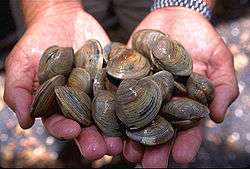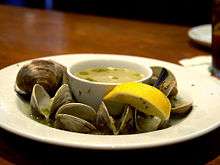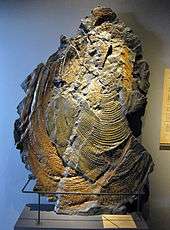Clam
| Clam | |
|---|---|
| | |
| Edible clams in the family Veneridae | |
| Scientific classification | |
| Kingdom: | Animalia |
| Phylum: | Mollusca |
| Class: | Bivalvia |
Clam is the general common name of any mollusks within the class Bivalvia. More specifically, true clams are bivalves having two shells of equal size connected by two adductor muscles and having a powerful burrowing foot. They are infaunal, spending most of their lives partially buried in the sand of the ocean floor. These characteristics distinguish the true clams from other bivalves, such as oysters, mussels, and scallops.[1]
Remains first appeared in Cambrian age rocks 510 million years ago.[2] They presently live in both freshwater and marine habitats, and range in adult size from nearly microscopic to the giant clam, which can weigh 200 kg (440 lb). Some have life cycles of only one year, while at least one has been discovered that may be over 500 years old.[3] They lack heads but most can react to changes in light and some, such as the scallops, have rudimentary eyes. Though a common food item, many are too small to be useful as food, and not all species are considered palatable. All clams have two calcareous shells or valves joined near a hinge structure with a flexible ligament, and all are filter feeders.

Terminology
In the United States, the word "clam" has several different meanings. First, it can generally refer to all bivalve molluscs. In the more limited sense, the term refers to the large subset of bivalves living as infauna, rather than those attached to a substrate (like oysters and mussels) or those that lie and move near the bottom or swim (like scallops). It can also refer to one or more kinds of commonly consumed marine bivalves, such as in the phrase clam chowder, which refers to shellfish soup. Many edible clams are roughly oval-shaped or triangular; however, razor clams have an elongated parallel-sided shell, suggesting an old-fashioned straight razor.
In the United Kingdom, "clam" is one of the common names of various species of marine bivalve mollusc,[4] but it is not used as a term covering either edible clams that burrow or bivalves in general.
Numerous edible marine bivalve species live buried in sand or mud and respire by means of siphons, which reach to the surface. In the United States, these clams are collected by "digging for clams" or clam digging.
The word "clam" is used in the idiom "to clam up", meaning to refuse to talk or answer, based on the clam behaviour of quickly closing the shell when threatened.[5] A "clamshell" is the name given to a container or mobile phone consisting of two hinged halves that lock together. Clams have also inspired the phrase "happy as a clam", short for "happy as a clam at high tide" (when it can't easily be dug up and eaten).[6]
Anatomy

A clam's shell consists of two (usually equal) valves, which are connected by a hinge joint and a ligament that can be external or internal. The ligament provides tension to bring the valves apart, while one or two adductor muscles can contract to close the valves. Clams also have kidneys, a heart, a mouth, a stomach, a nervous system and an anus. Many have a siphon.
As food
| Wikimedia Commons has media related to Clam dishes. |


North America
In culinary use, within the eastern coast of the United States, the term "clam" most often refers to the hard clam Mercenaria mercenaria. It may also refer to a few other common edible species, such as the soft-shell clam, Mya arenaria and the ocean quahog, Arctica islandica. Another species commercially exploited on the Atlantic Coast of the United States is the surf clam Spisula solidissima. Scallops are also used for food.
Clams can be eaten raw, steamed, boiled, baked or fried. They can also be made into clam chowder or they can be cooked using hot rocks and seaweed in a New England clam bake.
Japan
In Japan, clams are often an ingredient of mixed seafood dishes. They can also be made into hot pot, miso soup or Tsukudani. The more commonly used varieties of clams in Japanese cooking are the Shijimi (Corbicula japonica), the Asari (Venerupis philippinarum) and the Hamaguri (Meretrix lusoria).
Italy
In Italy, clams are often an ingredient of mixed seafood dishes or are eaten together with pasta. The more commonly used varieties of clams in Italian cooking are the Vongola (Venerupis decussata), the Cozza (Mytilus galloprovincialis) and the Tellina (Donax trunculus). Though Dattero di mare (Lithophaga lithophaga) was once eaten, overfishing drove it to the verge of extinction (it takes 15 to 35 years to reach adult size and could only be harvested by smashing the calcarean rocks that form its habitat) and the Italian government has declared it an endangered species since 1998 and its harvest and sale are forbidden.
India
Clams are eaten more in the coastal regions of India, especially in the Konkan, Kerala, Bengal and Karnataka regions.
In Kerala clams are used to make curries and fried with coconut. In Malabar region it is known as "elambakka" and in middle kerala it is known as "kakka". clams curry made with coconut is a rather delicious dish from malabar especially in Telicherry region. In the south western coast of India, also known as the Konkan region in the state of Maharashtra, clams are used to cook curries and side dishes, like Tisaryachi Ekshipi, which is clams with one shell on. Beary Muslim households in the Mangalore region prepare a main dish with clams called Kowldo Pinde. Kowl is "clams" in the local language, and Pinde is "rice ball".
Trinidad and Tobago
Clams and shellfish are locally called "chipchip", and local fishermen sell them in rural markets.
Religion
The Moche people of ancient Peru worshiped the sea and its animals. They often depicted clams in their art.[7]
In Judaism, clams are considered non-kosher (treif) along with all other shellfish.
As currency
Some species of clams, particularly Mercenaria mercenaria, were in the past used by the Algonquians of Eastern North America to manufacture wampum, a type of shell money.[8]
Species

Edible:
- Grooved carpet shell: Ruditapes decussatus
- Hard clam or Northern Quahog: Mercenaria mercenaria
- Manila clam: Venerupis philippinarum
- Soft clam: Mya arenaria
- Atlantic surf clam: Spisula solidissima
- Ocean quahog: Arctica islandica
- Pacific razor clam: Siliqua patula
- Pismo clam: Tivela stultorum (8 inch shell on display at the Pismo Beach Chamber of Commerce)
- Geoduck: Panopea abrupta or Panope generosa (largest burrowing clam in the world)
- Atlantic jackknife clam: Ensis directus
- Lyrate Asiatic hard clam: Meretrix lyrata
- Ark clams, family Arcidae (most popular in Indonesia and Singapore)
Not usually considered edible:
- Nut clams or pointed nut clams, family Nuculidae
- Duck clams or trough shells, family Mactridae
- Marsh clams, family Corbiculidae
- File clams, family Limidae
- Giant clam: Tridacna gigas
- Asian or Asiatic clam: genus Corbicula
- Peppery furrow shell: Scrobicularia plana
- Pearl oysters: genus Pinctada
See also
References
- ↑ "Clam", Encyclopædia Britannica. Encyclopædia Britannica Inc., 2016. Accessed 29 October 2016.
- ↑ Andrew Alden. "Bivalves". About.com Education.
- ↑ Danielle Elliot (November 14, 2013). "Ming the Clam, World's Oldest Animal, Was Actually 507 Years Old". CBS News. Retrieved 15 November 2013.
- ↑ "Oxford Dictionaries – Dictionary, Thesaurus, & Grammar". askoxford.com.
- ↑ "clam up – Idioms – by the Free Dictionary, Thesaurus and Encyclopedia". The Free Dictionary. Farlex. Retrieved 19 September 2011.
- ↑ "happy as a clam – Idioms – by the Free Dictionary, Thesaurus and Encyclopedia". The Free Dictionary. Farlex. Retrieved 19 September 2011.
- ↑ Berrin, Katherine & Larco Museum. The Spirit of Ancient Peru:Treasures from the Museo Arqueológico Rafael Larco Herrera. New York: Thames and Hudson, 1997.
- ↑ Kurlansky, Mark (2006), The Big Oyster: History on the Half Shell, Penguin Group, pp. 16,30–31, ISBN 0-345-47638-7, OCLC 60550567.
External links
| Look up clam in Wiktionary, the free dictionary. |
 Media related to Bivalvia at Wikimedia Commons
Media related to Bivalvia at Wikimedia Commons- Clam stir fry
- Deep In The Ocean A Clam That Acts Like A Plant Science Daily March 2, 2007
- Hardshell Clams

